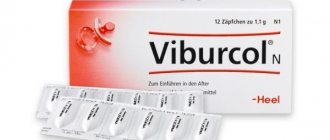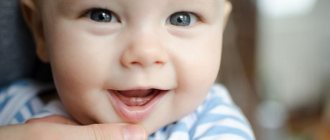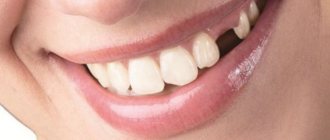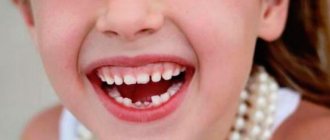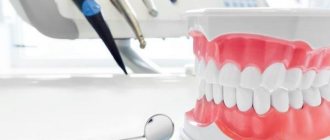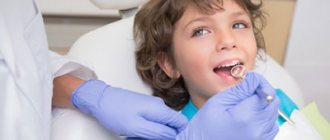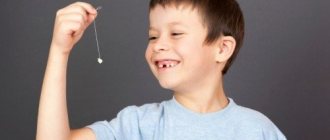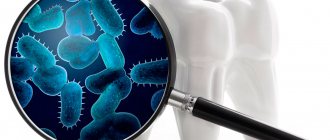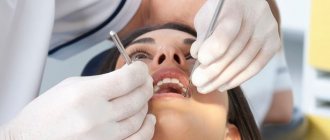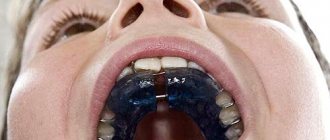August 14, 2018
Averyanova Sveta
Age characteristics are a common subject of concern for parents. A two-year-old baby is developing rapidly. But while adults can help a child with skills and abilities, they cannot influence physiological processes: growth and development. Questions about how many teeth a child should have at 2 years old and whether they are positioned correctly concern many mothers.
Cutting speed
At first, parents wait impatiently for the first tooth, examining the baby's gums for restless behavior. When the incisors begin to erupt one after another, it is rare for a baby to tolerate this process calmly. Moms and dads often want to speed it up, but little depends on them. The speed of teething is affected by:
- features of hereditary predisposition;
- the state of the endocrine system of the baby and mother during pregnancy;
- the state of the environment in the area of residence;
- state of the immune system;
- period of appearance of the first incisor;
- infectious diseases and rickets;
- supply of nutrients to the body.
Interesting fact. Often teeth appear early in firstborns and children of late-parous parents. The most problematic one is usually the first tooth.
Pathologies of tooth growth in two-year-old children
The teething of a child according to a schedule, that is, according to a scheme compiled from average statistical indicators, is evidence of the normal development of the child and the process of teething itself (for more details, see the article: scheme and timing of teething in a child). Minor deviations in one direction or another are acceptable, which is considered within normal limits. Atypical situations also occur, although they are rare. They may indicate the presence of pathology and impaired development of the baby. Only a doctor can determine whether there is a pathology or not.
A shift in the timing of eruption by several months usually indicates a serious disease - rickets, which develops against the background of an acute deficiency of vitamin D, due to which the body practically does not absorb calcium, which is necessary for the healthy growth of bones and teeth, in particular.
A tooth can also erupt outside the arch of the dentition, which is an abnormal phenomenon and requires the intervention of a specialist. One of the serious pathologies is the incorrect formation of a single unit or several at once. They are of irregular shape, color, and occupy an unusual position in the mouth. Typically, such defective units must be removed, but the decision to correct the problem rests with the dentist.
Read also: At what age does the first baby tooth fall out?
Stages of eruption
Incisors, molars and others are formed even before birth - 6–7 weeks from the start of pregnancy. By the second half of the interesting period, at about 5 months, the fetus has the rudiments of permanent teeth. They appear differently for everyone: some are born with one or two, while others smile with a toothless mouth even within a year.
Typically, the first thing observed is the eruption of the central lower incisors; this occurs in the period from 4 to 6 months.
Then, at short intervals, the same positions are cut from above. By the age of one year, the baby acquires lateral incisors.
The second year is a time of big changes: from 1.3 to 1.5 years, the baby’s first molars appear: first the upper, then the lower; towards the end, the last of the standard set of baby teeth often begins to emerge.
The upper canines erupt at approximately 14 to 22 months of age, and the lower canines at 17 to 23 months.
Thus, by the age of 2 years, a baby can usually boast 16 teeth . After a year and up to 2.5, two more pairs of upper and lower molars erupt.
Table 1. Teething pattern by month (Important! The table can be scrolled right and left).
| Name of teeth | Upper jaw | Lower jaw |
| Central incisors | 6-8 months | 5-7 months |
| Literal incisors | 8-11 months | 7-9 months |
| First molars (molars) | 10-16 months | 10-16 months |
| Second molars (molars) | 20-30 months | 20-30 months |
| Fangs | 16-22 months | 17-23 months |
Typically, the time for a tooth to appear during the breast period lasts from two days to a week; if the child suffers longer, this is a reason to consult a doctor. Protect the peace and health of the baby: do not go to visit or receive friends, refuse to visit noisy crowded places.
How many teeth should a 2 year old have?
The process of formation of the primary dentition in accordance with average statistical data can be traced in the table:
| Age | What teeth are coming through? |
| 6 months | Incisors (lower central) |
| 8 months | Incisors (upper central) |
| 10 months | Incisors (upper lateral) |
| 1 year | Incisors (lower lateral) |
| 14–16 months | Molars – fourth teeth (lower and upper) |
| 16–18 months | Upper canines |
| 18–20 months | Lower canines |
| 20–24 months | Molars – fifth teeth (lower and upper) |
In some tables you can find later dates for teething - up to 33 months of life. Each person’s body develops according to an individual plan, so the time of appearance of certain teeth may differ in different children. Taking into account individual characteristics, a 2-year-old child may have from 16 to 20 teeth .
The number of teeth that a child should have at a given age can be calculated using the formula. To do this, you need to subtract 4 from the number of months lived. Returning to the table, you can check the calculations: 6 months minus 4 equals two (2 lower incisors), 12 months minus 4 equals 8 (paired lower and upper central and lateral incisors).
Permissible deviations
Don't be too alarmed if teeth erupt at intervals of several months or in the wrong order. But if the baby does not have incisors after 1 year, this is a reason to consult a specialist.
Usually, when the first tooth appears late, then all the others begin to cut late. If there is a hereditary factor, there is no need to worry.
Factors influencing deviations from the norm:
- weakened immune system;
- use of medications by the mother during pregnancy;
- sucking on a pacifier for a long time;
- lack of breastfeeding, bottle feeding;
- lack of vital elements in the diet;
- lack of necessary load on the jaws (mashed food).
Premature babies, babies with high body weight, and children on IV are at risk.
An acceptable deviation from the norm is a lag of six months. If a tooth begins to erupt with a discoloration, shape, or in the wrong direction, the baby should be shown to the dentist.
It is advisable to consult if teeth appeared too early or one of the paired incisors or molars is missing for a long time. Gaps in the dentition can be both normal and pathological.
In this video, the pediatrician talks about how many teeth should be at 2 years old and what to do if your child has deviations from the norm.
Molar milk teeth
Many parents know nothing about the characteristics of primary incisors. A few interesting facts that will certainly be useful to parents:
- the deciduous incisors also have a root; They can form in the last stages of pregnancy; when the time comes to replace the primary incisor with a permanent one, the root gradually resolves on its own; temporary incisors have softer enamel.
When the time comes to change canines and children’s molars begin to erupt, the root gradually weakens. At this time, the cutter begins to wobble. If you do not pull it out, but wait until it falls out on its own, under the fallen fang you will be able to detect the emerging permanent molar incisor. The formation of a permanent incisor or canine occurs against the background of weakening of the root of the baby tooth.
The main part of the molar permanent incisors is formed before the age of 8-9 years. Some of them appear at 12-13 years of age.
When permanent permanent teeth erupt in young children, symptoms may be accompanied by an increase in temperature. At what age do permanent permanent teeth emerge in children depends on the characteristics of the child’s body. Sometimes it happens that a child is only 2 years old, but molars are already being cut.
How to make teething easier
By six months, when teeth usually make themselves felt for the first time, the immunity the baby received during pregnancy and breastfeeding weakens. The first colds and acute respiratory infections appear, the functioning of the intestines and stomach is upset. The process, painful in itself, becomes more complicated. Parents may observe the following symptoms:
- refusal to eat due to sore gums;
- cough caused by excess saliva;
- swelling in the gum area, pain;
- anxiety, poor sleep;
- temperature up to 38–39 degrees.
The baby begins to feel the need to get rid of unpleasant sensations; he tries to put any object he can reach into his mouth. During this period, it is important to ensure the sterile cleanliness of toys, pacifiers and bedding so that the child does not become infected. Keep the lower part of your face clear of saliva, otherwise irritation may occur.
According to many mothers and pediatricians, the baby’s condition is best facilitated by the use of refrigerated teethers. Modern models are safe, fit comfortably in a baby’s hand, and can be sterilized.
You can give your baby a piece of carrot or hard fruit only if he has no teeth. Cookies, crackers and dry goods are excluded - the baby may choke. They can be offered to your toddler when he approaches the age of two years.
Medicines prescribed by your pediatrician, based on paracetamol or Ibufen, will help reduce your temperature. Depending on the age, the child is given syrup or candles. If there is no fever, it is enough to wipe the baby with a wet diaper. If the thermometer readings begin to rise, it is better to call an ambulance.
Relieves itching in the gums and teething with a light massage. When using gels and ointments to reduce gum sensitivity, check to see if they contain lidocaine. This substance briefly relieves the symptoms of toothache, but can have a bad effect on heart function. Homeopathic medicines help some children.
Provide the baby with favorable conditions: air, cleanliness and coolness.
Important. The use of any medications at such a tender age should be strictly agreed with the pediatrician.
How many teeth does your child have at 2 years old?
- From 16 and over 51%, 479 votes
479 votes 51%479 votes - 51% of all votes
- From 10 to 16 42%, 398 votes
398 votes 42%
398 votes - 42% of all votes
- From 4 to 10 6%, 53 votes
53 votes 6%
53 votes - 6% of all votes
- From 0 to 4 1%, 7 votes
7 votes 1%
7 votes - 1% of all votes
- Z*0%, 4 votes
4 votes
4 votes - 0% of all votes
- None 0%, 3 votes
3 votes
3 votes - 0% of all votes
Total votes: 944
14.08.2018
×
You or from your IP have already voted.
If your child has a fever
A temperature of 37 degrees is considered normal; up to 37.5 this will also not be considered a special or complicated situation. Children usually feel fine with such a slight increase in temperature. Naturally, there is no point in giving an antipyretic in this case.
If the temperature rises above 38 degrees, it is worth saying that inflammation or infection has joined the teething process. This situation requires seeing a doctor (he needs to be called to your home), and only his recommendations will be your tactics in future behavior.
Call your pediatrician if you have a fever
During teething the temperature is usually:
- rises in the evening, at night;
- lasts up to three days;
- requires an antipyretic if the child is suffering.
There is no exact temperature mark when you need to go for medicine. Of course, a temperature above 39 is already a serious signal; in this case, medical supervision is required. But some parents strive to bring down the temperature at 37.5, while others believe the figure is 38.5 -39 degrees.
Temperatures above 39 degrees are dangerous because the child may experience seizures. The baby’s brain is still adapted to such changes in body temperature, and such a neurological reaction is natural. But this condition is not harmless - be sure to call a doctor. It is also dangerous that fever causes dehydration and exhaustion of the small body. The younger the child, the more dangerous this situation is: fever in children, especially persistent fever, requires hospitalization.
If the temperature is very high, seizures may occur
And remember that the antipyretic should be strictly for children, ideally recommended by a doctor. These are usually paracetamol-based drugs. If they do not help, you can give the child Ibuprofen (but it is prescribed to children from one year old).
But under no circumstances should children be given medications of the aspirin and analgin group. These are toxic drugs that cause side effects.
Ibuprofen
An excellent tactic for high temperatures would be to humidify the air in the room, regularly ventilate (while the child is in another room), drink plenty of fluids and eat as desired. The child should drink a lot of warm drinks and eat only when he wants to. Avoid dry air, wrapping yourself up in three pajamas and two blankets. If a child wants to play at a high temperature, there is no need to force him to go to bed.
Give your child warm drinks
It is important to understand that if the temperature is elevated for more than three days, it is unlikely that the problem is teething. And when it still doesn’t go astray, urgently call a doctor and look for the real reason for this reaction of the body.
Video: Increase in temperature during teething
Teething is not a very long period. By the age of three, it is definitely completed, and then you will already wait for the loss of milk teeth and the growth of permanent ones. As a rule, the child tolerates these processes normally. To make sure everything is in order, visit your pediatric dentist every six months. You can take care of baby teeth from the moment they appear. Teach your child to brush his teeth twice a day, monitor the quality of brushing. Toothache, folk remedies to kill the nerve, read the link.
Teach your child to brush his baby teeth
How to strengthen baby teeth
The mother should take care of the baby’s teeth during, or better yet before, pregnancy: provide herself with adequate nutrition, eliminate bad habits and, if possible, not take medications. Before and after the first tooth appears, it is advisable to follow the following rules:
- Eliminate sugar from your child's diet.
- When introducing complementary foods, give preference to vegetables.
- Correctly and promptly clean your tongue, teeth and gums of plaque after eating.
- In winter, after consulting with your pediatrician, give your child medications to prevent rickets.
- Introduce dairy products, meat and fish into the diet in a timely manner.
Folk method. Chicken egg shells are a good grandmother’s method for strengthening tooth tissue. It is boiled in boiling water for 2–5 minutes to prevent infection, cleared of the film, ground to a powder and given to the child a pinch with a drop of lemon juice.
Preventing dental problems
To prevent the tiny pearls in your baby’s mouth from starting to turn black, deteriorate, hurt and crumble, you need to:
- Introduce complementary foods and solid foods at the recommended times.
- If your baby is allergic to milk proteins, you can try adding sesame seeds to the food. This product is a leader in plant calcium content.
- Make sure that your baby’s food contains the required amount of microelements and vitamins.
- Wean off pacifiers, bottles, and thumb sucking for up to a year.
- Avoid sugary drinks at night and during sleep.
- Observe hygiene rules when using baby utensils and pacifiers. You should not lick a pacifier or spoon and offer it to your baby.
- Most often, a two-year-old baby goes to kindergarten for the first time. Before this event, it is advisable to sign up for a procedure for examining and sanitation of the oral cavity.
Useful tips
The root cause of diseases affecting the baby’s oral cavity is the incorrect actions of parents. To avoid problems such as caries, fluorosis, and enamel hypoplasia in the future, the following recommendations must be followed:
- For any abnormalities, make an appointment with your child to see a doctor.
- After teeth emerge, clean them with a special baby brush that fits on your finger.
- After 2 years, teach children to brush their teeth independently under adult supervision.
- For very small babies, brush their teeth with a weak soda solution or just with a damp brush. A 2-year-old child can brush his teeth using toothpaste.
- Buy a toothbrush according to your age group. The same goes for pasta.
- Brush your teeth with gentle movements without pressure.
- Choose fluoride-free baby toothpastes.
Folk remedy. You can gently clean children's teeth from pathogenic microflora with propolis infusion, a water-salt solution, or a decoction of sage or chamomile.
About childhood caries
Today it is a widespread disease among children two to three years old. Many parents, upon hearing such a diagnosis from a dentist, are simply confused. Where? Why? After all, they regularly brush their children’s teeth and don’t indulge in sweets; they regularly feed them calcium-containing foods!
In this case, the causes of caries have intrauterine roots. Perhaps the pregnant woman consumed little fermented milk products, and the developing child’s body experienced a calcium deficiency. Perhaps the expectant mother suffered from infectious diseases and was treated with medications that are undesirable during pregnancy, especially in its early stages. Medicines negatively affect tooth buds. Therefore, the child’s baby teeth suffer from caries.
There are other reasons that lead to common dental disease in children:
- Prolonged use of a pacifier.
- Improper oral care for your baby.
- Bottle feeding him for a long time.
To prevent the occurrence of childhood caries, you need to systematically brush your baby’s teeth. By the age of two, the procedure should already become a habit. Today there is a huge range of hygiene products produced specifically for children of early preschool age. They are safe and taste good. As for toothbrushes, they should be soft so that cleaning the chewing organs gives the child only pleasant sensations. Nowadays there are special brushes that are put on the finger. Their appearance is interesting and attractive.
Read also: The baby tooth has not fallen out, but the molar is growing
As for the treatment of caries of baby teeth, special filling eliminates the need to remove them. And the latter can lead to the development of malocclusion in children.
